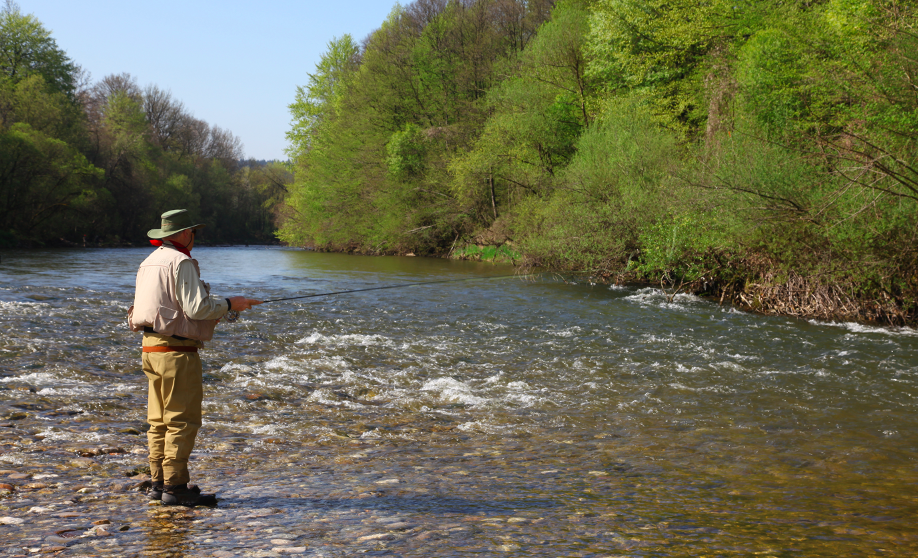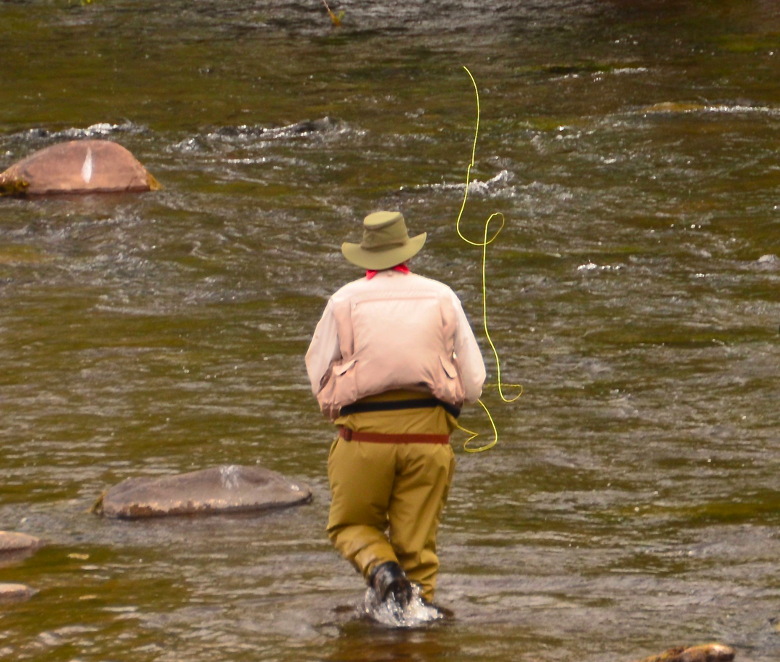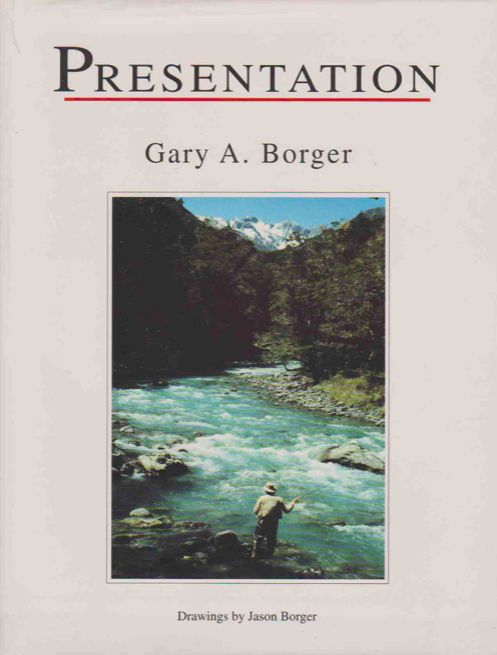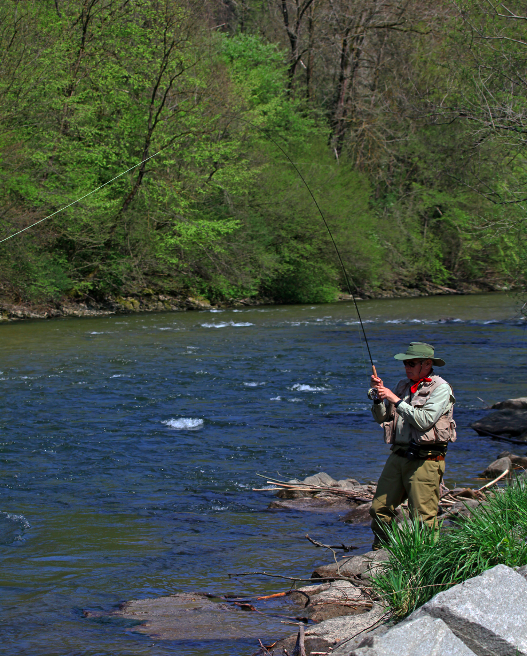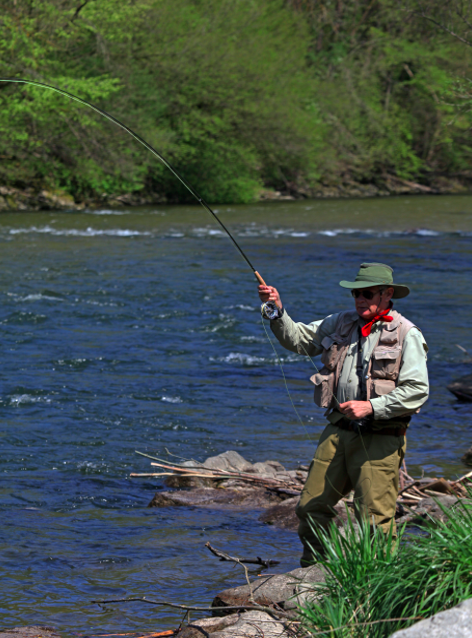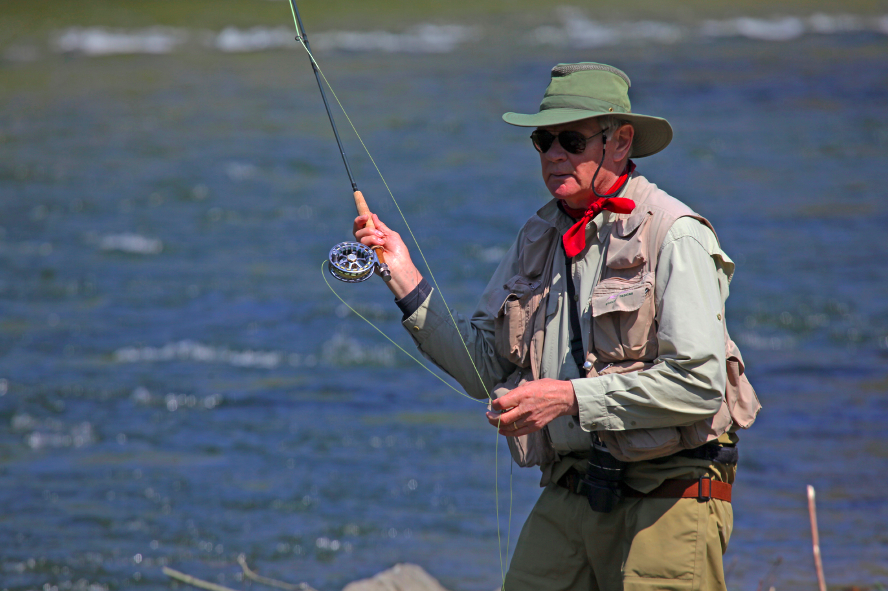
Gary Borger
1. Choice of equipment Rods, reels, fly lines, fly floatants, clothes, glasses and other useful items.
For typical dry fly fishing for trout I prefer a 9-foot 5-weight graphite rod. Currently I am using Hardy’s Wraith series coupled to their MA reel. It’s a great casting tool and the reel has smooth operation and sufficient drag for trout. I use long-head (45-50 feet), weight forward lines, and any good fly floatant. I wear tan polarizing sunglasses because they offer the greatest contrast in freshwater systems, and a broad brimmed hat to shade my eyes from all directions. Clothing should be of natural colors that blend into the surroundings, making the fly fisher less noticeable to the fish. I prefer waist high waders because I wade as little as possible, and like the cooler character of these waders.
The fish were all in the shallows between me and the heavy currents on the far side; most anglers would be wading this area where the fish fed all day, one was five pounds.
2. Leader material, build up, length and knots.
I use Maxima Chameleon for the butt and tapered section of my leader and Stroft for my tippets. When fishing dry flies I prefer a Harvey-style leader—long and soft--one that doesn’t straighten but falls in “S” waves onto the surface of the water, helping to eliminate or minimize drag. Classically my leaders are 12 to 15 feet in length. I connect the segments with either a double surgeons or blood knot. I also use a 2.15mm tippet ring between the last two segments of the leader, allowing me to change the last segment swiftly without changing leader dynamics.
A very fine rainbow on the dry fly, taken in less than a foot of water in the area shown in Figure 01.
3. Approach and stealth.
Wear clothing that blends in with the environment, and move slowly and carefully. When approaching closer than 30 feet stay low. I cast more sidearm that with the classic overhead cast to keep the line low and less visible to the fish (Figure 04).
Fishing the dry requires that angler be well versed in casting, mending, and line handling.
4. Reading the water.
No reading necessary when the hatch is on because the fish reveal their presence. However, move cautiously because not all the fish are rising all the time. Pay close attention to every potential place fish might be feeding in the thatch.
In non-hatch times (opportunistic feeding periods), pay very close attention to every possible feeding lie—shallow areas (less than knee deep) in any part of the stream (Figure 01). Many times big fish will be in the shallows watching for food (Figure 02), and a careless approach will put them down without the anglers ever knowing the fish was there.
Classically I cast with the rod a bit sidearm to keep the line lower over the surface and less visible to the fish.
5. Casting ability which casts are essential.
Casting and mending are the core skills in presentation. Presentation is getting the fly to the fish (casting) in such a way that the fish things the fly is something good to eat (mending) without spooking the fish in the process (the angler as predator).
So, everything that one can learn about casting and mending can be used in our pursuit of fish with the dry fly (Figure 03).
Typically I use an Elliptical Stroke with the rod a bit sidearm to keep the line low so its less visible to the fish and less influenced by any wind (Figure 04). But I cast however necessary to get the fly to target .
I use in-the-air mending as my primary form of mending so that the fly drops to the water ready to fish. On-the-water mending is secondary and used to reposition slack introduced by in-the air mends. I use the basic four in-the-air meds the most, obviously: Reach Mend, Puddle Mend, Curve Mend, and Parachute Mend.
I also use curve casts a great deal to position the fly downstream of the line and leader.
6. Entomology, what should we know.
Obviously, the more one knows about the fish’s food organisms, the better, but a basic understanding of the general life habits of the insects that hatch at the surface (mayflies, caddises, and midges) is all that’s really necessary for successful dry fly fishing in the hatch. Much more important is to be able to eliminate drag on the fly (especially micro-drag).
GARY BORGER - ENTOMOLOGY KIT
7. Rise forms Can they tell us something?
In order to take an insect out of the surface film (emergers) or off the film (dry fly) the trout must open its mouth and put its snout above the surface. Trout literally bite the insect out of, or off of, the surface film. Bass can suck the morsel in, trout cannot.
If there are bulging rise forms, with no snouts ever visible, then the fish are feeding just under the surface. If snouts are visible then the trout are taking emergers or fully developed dry flies. Watch the rises carefully, if no fully developed adults are ever seen being eaten, then the fish are on the emergers. Typically I go straight to the emerger rather than the full blown adult imitation.
8. Fly selection, Size, shape, materials, which flies are essential.
This is a huge topic, and one that depends very much upon the specific insets that are being imitated. Size, shape, color, and behavior are the four triggers that fish watch for when feeding selectively, and the four that we should imitate in our fly designs. There is a huge selection of imitations available, all of which catch fish. It is more critical that one is able to fish the dry fly dead drift; a skill that many anglers find daunting. On a scale of 1—10 with 10 being the worst, Drag comes in at 1,000!! Really work at keep drag out of the formula with Harvey-style leaders and mending every cast..
During opportunistic times, dry flies may be fished in a wide variety of ways, from absolute dead drift, to dead drift with an occasional twitch, to skated, even sunken and fished like a wet fly or nymph. In such periods, fly visibility to angler and fish is every bit as important as any food imitative suggestion by the design.
9. Presentation and drifts.
Presentation is getting the fly to the fish (casting) in such a way that the fish thinks the fly is something good to eat (mending), without spooking the fish in the process (the angler as predator). All three are essential and critical. If there is any criticism that I would make of the average dry fly angler it is that they almost never mend, or use only mending-on-the-water. Every cast should be mended when fishing the dry fly in order to maximize a dead drift, and in-the-air mending is far superior to mending on-the-water.
10. Upstream or downstream?
Presentation is not a matter of upstream or down. When dead-drifting the dry, it is a matter of getting the fly to the fish without drag. On some waters, fishing the dry fly is only permitted on an upstream cast. So, use whatever tactic is the very best to achieve the goals of presentation.
Personally I prefer to fish a dead-drift dry downstream when possible, but I have no hesitation to fish upstream or across stream when that is the most effective way to reach the fish.
11. fighting fish.
One first needs to understand how to use the different sections of the rod to apply pressure to the fish. Tip pressure with the rod upright (Figure 05) is very delicate (a 9-foot 5-weight’s tip pressure is ½ ounce). The lower the rod is positioned, the deeper it bends. When held at a 45-50 degree angle above the horizontal, the rod is bending mostly in its mid section (Figure 06). Dropped to 15 degrees above the surface or lower, the rod is flexing mostly in the butt section and applying the greatest possible rod pressure to the fish. Pointing the rod directly at the fish eliminates all rod flexure and gives the fly rodder a direct pull against the fish, thus exerting the greatest possible pressure.
Pulling from the side, rather than angling the rod upward puts the greatest pressure against the fish’s swimming muscles—they are designed to move the fish’s body side to side.
Typically when fishing for trout, I use a tip-set (to minimize tippet breakage), but as soon as I can I get side pressure on the fish. I move the rod around a great deal, using both side pressure when possible, and lifting the rod more upright as needed. For example, when the fish runs, I hold the rod high with only tip pressure so that the leader and a minimum of line are in the water. This protects the often-delicate tippets that are used when fishing the dry.
Tip pressure is very light and used only when needed to assure the integrity of the tippet.
Mid-rod pressure occurs when the rod butt is angled up about 45-50 degrees above the horizontal.
